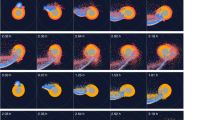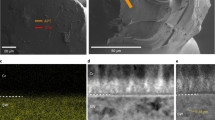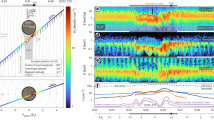Abstract
The atmospheric compositions of Venus and Earth differ significantly, with the venusian atmosphere containing about 50 times as much 36Ar as the atmosphere on Earth1. The different effects of the solar wind on planet-forming materials for Earth and Venus have been proposed to account for some of this difference in atmospheric composition2,3, but the cause of the compositional difference has not yet been fully resolved. Here we propose that the absence or presence of an ocean at the surface of a protoplanet during the giant impact phase could have determined its subsequent atmospheric amount and composition. Using numerical simulations, we demonstrate that the presence of an ocean significantly enhances the loss of atmosphere during a giant impact owing to two effects: evaporation of the ocean, and lower shock impedance of the ocean compared to the ground. Protoplanets near Earth's orbit are expected to have had oceans, whereas those near Venus’ orbit are not, and we therefore suggest that remnants of the noble-gas rich proto-atmosphere survived on Venus, but not on Earth. Our proposed mechanism explains differences in the atmospheric contents of argon, krypton and xenon on Venus and Earth, but most of the neon must have escaped from both planets’ atmospheres later to yield the observed ratio of neon to argon.
This is a preview of subscription content, access via your institution
Access options
Subscribe to this journal
Receive 51 print issues and online access
$199.00 per year
only $3.90 per issue
Buy this article
- Purchase on Springer Link
- Instant access to full article PDF
Prices may be subject to local taxes which are calculated during checkout



Similar content being viewed by others
References
Donahue, T. M. & Pollack, J. B. in Venus (eds Hunten, D., Colin, L., Donahue, T. & Moroz, V.) 1003–1036 (Univ. Arizona Press, Tucson, 1983)
Wetherill, G. W. Solar wind origin of 36Ar on Venus. Icarus 46, 70–80 (1981)
Sasaki, S. Off-disk penetration of ancient solar wind. Icarus 91, 29–38 (1991)
Kokubo, E. & Ida, S. Oligarchic growth of protoplanets. Icarus 131, 171–178 (1998)
Chambers, J. E. Making more terrestrial planets. Icarus 152, 205–224 (2001)
Kominami, J. & Ida, S. Formation of terrestrial planets in a dissipating gas disk with Jupiter and Saturn. Icarus 167, 231–243 (2004)
Abe, Y. & Matsui, T. Early evolution of the Earth: Accretion, atmosphere formation, and thermal history. J. Geophys. Res. 91 (suppl.), E291–E302 (1986)
Hayashi, C., Nakazawa, K. & Mizuno, H. Earth's melting due to the blanketing effect of the primordial dense atmosphere. Earth Planet. Sci. Lett. 43, 22–28 (1979)
Storm, S. E., Edwards, S. & Skrutskie, M. F. in Protostars and Planets III (eds Levy, E. H. & Lunine, J. I.) 837–866 (Univ. Arizona Press, Tucson, 1993)
Abe, Y., Ohtani, E., Okuchi, T., Righter, K. & Drake, M. in Origin of the Earth and Moon (eds Canup, R. M. & Righter, K.) 413–433 (Univ. Arizona Press, Tucson, 2000)
Genda, H. & Abe, Y. Survival of a proto-atmosphere through the stage of giant impacts: the mechanical aspects. Icarus 164, 149–162 (2003)
Cameron, A. G. W. The giant impact revisited. Lunar Planet. Sci. XXIII, 199–200 (1992)
Melosh, H. J. The history of air. Nature 424, 22–23 (2003)
Ahrens, T. J. in Origin of the Earth (eds Newsom, H. E. & Jones, J. H.) 211–227 (Oxford Univ. Press, New York, 1990)
Ahrens, T. J. Impact erosion of terrestrial planetary atmospheres. Annu. Rev. Earth Planet. Sci. 21, 525–555 (1993)
Chen, G. Q. & Ahrens, T. J. Erosion of terrestrial planet atmosphere by surface motion after a large impact. Phys. Earth Planet. Inter. 100, 21–26 (1997)
Abe, Y. Physical state of the very early Earth. Lithos 30, 223–235 (1993)
Newman, M. J. & Rood, R. T. Implications of solar evolution for the Earth's early atmosphere. Science 198, 1035–1037 (1977)
Hayashi, C. Structure of the solar nebula, growth and decay of magnetic fields and effects of magnetic and turbulent viscosities on the nebula. Prog. Theor. Phys. Suppl. 70, 35–53 (1981)
Anders, E. & Grevesse, N. Abundances of the elements: meteoritic and solar. Geochim. Cosmochim. Acta 53, 197–214 (1989)
Zahnle, K. in Protostars and Planets III (eds Levy, E. H. & Lunine, J. I.) 1305–1338 (Univ. Arizona Press, Tucson, 1993)
Pepin, R. O. On the origin and early evolution of terrestrial planet atmospheres and meteoritic volatiles. Icarus 92, 2–79 (1991)
Dauphas, N. & Marty, B. Inference on the nature and the mass of Earth's late veneer from noble metals and gases. J. Geophys. Res. 107, doi:10.1029/2001JE001617 (2002)
Melosh, H. J. & Vickery, A. M. Impact erosion of the primordial atmosphere of Mars. Nature 338, 487–489 (1989)
Newman, W. I., Symbalisty, E. M. D., Ahrens, T. J. & Jones, E. M. Impact erosion of planetary atmospheres: Some surprising results. Icarus 138, 224–240 (1999)
Kasting, J. F. & Pollack, J. B. Loss of water from Venus. I. Hydrodynamic escape of hydrogen. Icarus 53, 479–508 (1983)
Tillotson, J. H. Metallic Equations of State for Hypervelocity Impacts (Report No. GA–3216, General Atomic, San Diego, California, 1962)
Wagner, W. & Pruß, A. The IAPWS formulation 1995 for the thermodynamic properties of ordinary water substance for general and scientific use. J. Phys. Chem. Ref. Data 31, 387–535 (2002)
O'Keefe, J. D. & Ahrens, T. J. Cometary and meteorite swarm impact on planetary surfaces. J. Geophys. Res. 87, 6668–6680 (1982)
Richtmyer, R. D. & Morton, K. W. Difference Methods for Initial-value Problems 2nd edn (Interscience, New York, 1967)
Acknowledgements
We thank E. Asphaug for comments and suggestions. This work was supported by a JSPS Research Fellowship and the 21st Century Earth Science COE Program (the University of Tokyo).
Author information
Authors and Affiliations
Corresponding author
Ethics declarations
Competing interests
The authors declare that they have no competing financial interests.
Supplementary information
Supplementary Figure 1
This figure shows typical numerical results of the motion of an atmosphere and ocean. The distributions of velocity, pressure, density, and temperature are shown. (DOC 182 kb)
Supplementary Figure 2
This figure shows particle velocity-pressure relations of the Hugoniot curves for olivine, water, and gas. (DOC 204 kb)
Supplementary Methods
This section provides the estimation of the mass of the gravitationally-attracted solar atmosphere. (DOC 39 kb)
Rights and permissions
About this article
Cite this article
Genda, H., Abe, Y. Enhanced atmospheric loss on protoplanets at the giant impact phase in the presence of oceans. Nature 433, 842–844 (2005). https://doi.org/10.1038/nature03360
Received:
Accepted:
Issue Date:
DOI: https://doi.org/10.1038/nature03360
This article is cited by
-
Magma Ocean, Water, and the Early Atmosphere of Venus
Space Science Reviews (2023)
-
A super-massive Neptune-sized planet
Nature (2023)
-
Stochastic accretion of the Earth
Nature Astronomy (2022)
-
Origin of life-forming volatile elements in the inner Solar System
Nature (2022)
-
Ancient and recent collisions revealed by phosphate minerals in the Chelyabinsk meteorite
Communications Earth & Environment (2022)
Comments
By submitting a comment you agree to abide by our Terms and Community Guidelines. If you find something abusive or that does not comply with our terms or guidelines please flag it as inappropriate.



